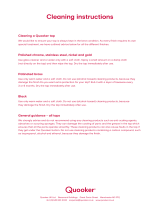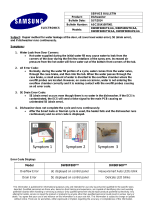
07
•
Do not put in, wash or dry articles that
have been cleaned in, washed in,
soaked in, or spotted with combustible
or explosive substances (such as
wax, oil, paint, gasoline, degreasers,
drycleaning solvents, kerosene,
vegetable oil, cooking oil, etc.). Improper
use can cause re or explosion.
•
In case of ood, stop using the product
and contact the LG Electronics service
centre. Contact with water can cause
electric shock.
•
Do not push down the door excessively,
when the appliance door is open. Doing
so may topple over the appliance and it
can cause the injury.
•
Use new hose-sets supplied with the
appliance. Old hose-sets should not
be reused. Water leakage may cause
property damage.
•
Do not touch the door during steam
cycles, drying or high-temperature
washing. The door surface can become
very hot. Allow the door lock to release
before opening the door. Failure to do
so may result in injury.
•
Do not use inammable gas and
combustible substances (benzene,
gasoline, thinner, petroleum, alcohol,
etc.) around the product. It may cause
explosion or re.
•
If the drain hose or inlet hose is frozen
during winter, use it only after thawing.
Freezing may cause re or electric
shock, and frozen parts may cause
product malfunction or reduction in
product life span.
•
Keep all washing detergents, softener
and bleach away from children. These
products contain poisonous materials.
•
Do not plug multiple products into
multiple socket-outlets or extension
cords. This can cause re.
•
Remove the power plug when you clean
the product. Not removing the plug may
result in electric shock or injury.
•
Do not touch the power plug with wet
hands. It can cause the electric shock
or injury.
•
When pulling out the power plug from
an outlet, hold the power plug, not the
cable. Damage of the cable can cause
the electric shock or injury.
•
Do not bend the power cable
excessively or place a heavy object on
top of it. Damage of the power cable
can cause electric shock or re.






















